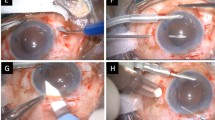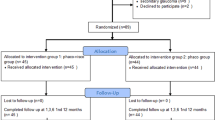Abstract
Purpose
We described the techniques and results of phacoemulsification using iris hook and scleral fixation of intraocular lens (IOL) in patients with secondary glaucoma associated with lens subluxation.
Methods
Eight eyes of seven patients with secondary glaucoma associated with lens dislocation, who had undergone the surgery, were retrospectively reviewed.
Results
At a mean of 23.5 months±13.6 (SD) after the surgery, the mean best-corrected visual acuity improved from 0.24±0.21 to 0.83±0.3, and mean intraocular pressure (IOP) was changed from 38.4±11.4 to 15.5±1.8 mmHg at the final examination. There were no vitreoretinal complications except cystoid macular oedema in one eye.
Conclusion
The technique appears to be safe and effective in terms of visual rehabilitation and controlling IOP in patients with secondary glaucoma associated with lens subluxation.
Similar content being viewed by others
Introduction
Selected patients with secondary glaucoma associated with lens dislocation or subluxation can be treated with laser peripheral iridoplasty or iridotomy.1 However, lensectomy is indicated in cases of uncontrolled intraocular pressure (IOP) despite previous attempts at medical or laser therapy.
There are many methods to remove lenses, including intracapsular cataract extraction (ICCE),2, 3 extracapsular cataract extraction (ECCE),4, 5 and pars plana vitrectomy with lensectomy.6, 7, 8, 9 Pars plana lensectomy (PPL) has provided good surgical outcomes, and is regarded as the standard surgical modality for the treatment of secondary glaucoma associated with lens dislocation.9 However, in some cases of lens subluxation and mild dislocation, pars plana vitrectomy seemed excessive. More and more studies utilizing phacoemulsification with iris hooks or a capsular tension ring (CTR) for lens dislocation cases are emerging.4, 5, 10, 11, 12
In this study, we modified these aforementioned techniques and applied them in cases of secondary glaucoma associated with lens subluxation.
Surgical technique
Following conjunctival incision, a 3.5 to 4.3 mm corneoscleral incision and 2 × 3 mm rectangular half-thickness scleral flaps at 2 and 7 o'clock directions were created using a sharp blade. This procedure was performed under subtenon's anaesthesia. If necessary, anterior vitrectomy was done before capsulotomy to remove vitreous in the anterior chamber. The anterior chamber was then filled with viscoelastics (Healon®, 1%), and a capsulorhexis was performed through the corneal incision, using a bent 26-gauge needle. Iris retractors were then inserted through the corneal stab incision sites, located in the area of the zonular dialysis. The retractors were hooked to the previously made capsulorhexis margin to stabilize the capsular bag during phacoemulsification (Figures 1 and 2). The number of iris retractors utilized varies from one to four, based on the range of zonular dialysis and cataractous changes. Appropriate tension was applied to the capsulorhexis margin by the iris retractors, pulling the capsule and lens complex towards the centre of the pupil. After hydrodissection and hydrodelineation, phacoemulsification was performed. The remaining lens capsule was removed by gentle tugging with the use of capsulorhexis forceps (Figure 3). Viscoelastics were then injected to reform the anterior chamber and prevent vitreous prolapse or incarceration. A double-armed 10–0 polypropylene (Prolene®) suture (STC6; Ethicon, Somerville, NJ, USA), connected to a straight needle, was passed under the scleral flap at 2 o'clock position, 1.0 mm posterior to the limbus. The suture was guided out of the eye, using a sharp, 27-gauge needle inserted through the opposite scleral bed at 7 o'clock position. The prolene suture was passed through the posterior chamber, where it was withdrawn from the corneoscleral incision with an H-shaped hook and cut. Foldable intraocular lens (IOLs) (Sensar® AR40; Allergan, Irvine, CA, USA) or silicone plate haptic IOLs (AA4204VL; Staar Surgical, Monrovia, CA, USA) were used for scleral fixation. The sutures were tied either in the middle of the haptic or at the end of the haptic hole. Each IOL was introduced into the eye through the corneoscleral incision, and the passing sutures were fixed at the scleral bed. After the aspiration of viscoelastics, 2% miostat was injected into the anterior chamber.
Results
Eight eyes of seven patients with secondary glaucoma associated with lens subluxation, who had undergone surgery (by KCY) between May 2002 and May 2004, were retrospectively evaluated. Table 1 shows patient characteristics and preoperative findings. Mean age was 58.3±11.5 years (SD); preoperative IOP was 38.4±11.4 mmHg under the usage of 1.9±1.7 IOP lowering medications. Four eyes (50%) had acute attack history (IOP>40 mmHg), and all four of those eyes received laser iridotomy. Five eyes had vitreous in the anterior chamber before surgery or laser. All patients, with the exception of patient 6, had zonular loss of approximately 180° and mild to moderate cataractous changes. Specific causes of lens dislocation in these patients, such as Marfan's syndrome, spherophakia, trauma history, or pseudoexfoliation, were not found. Patient 6 had bilateral secondary angle-closure glaucoma associated with lens dislocation, along with a positive family history. However, in this patient, there were no other ocular or systemic abnormalities. All patients except patient 2 received surgery because of high IOP (above 21 mmHg) under maximally tolerated medical treatment. Patient 2 underwent surgery for improvement of visual acuity rather than IOP control.
Table 2 shows the postoperative findings of patients after surgery. Postoperatively, all patients except patient 3 showed best-corrected visual acuity (BCVA) of 0.9 or better with Snellen-equivalent chart at the final follow-up visit. Patient 3 had a vitreous strand inside the anterior chamber after surgery, and received additional anterior vitrectomy 1 month after the first operation. Postoperatively, his visual acuity improved to 0.7 after the second procedure. However, 9 months after the first surgery, cystoid macular oedema (CME) developed and his BCVA worsened to 0.3. We recommended vitrectomy and steroid injection but the patient refused and discontinued any further treatment. Patient 5, who had a history of hypertension, underwent pupilloplasty to correct a dilated and atrophic pupil. His BCVA maintained 0.9 before and after pupilloplasty, but dropped to 0.4 due to branch retinal vein occlusion 22 months postoperatively. The IOP of all subjects except patient 6 were well-controlled without medication until the last follow-up. However, six eyes (75%) developed transient high IOP within 1 week after the operation, probably due to viscoelastics. Patient 2 received anterior chamber irrigation in his left eye to remove excessive viscoelastics, which were causing high IOP. Otherwise, there were no serious surgery-related vitreoretinal complications.
Discussion
Angle closure following pupillary block, occult phacolytic glaucoma, inflammation due to ciliary irritation, or vitreous in the anterior chamber may lead to increased IOP in secondary glaucoma associated with lens dislocation.13 In cases of angle closure following pupillary block, IOP can be controlled without difficulty with laser iridotomy and peripheral iridoplasty. However, if the IOP is not controlled or visual acuity is severely decreased due to lens problems, lens removal is necessary. There are many ways to extract the lens; including ICCE, and ECCE such as phacoemulsification, and PPL. ICCE has a short operation time, but requires a large corneoscleral incision and has more frequent vitroretinal complications.2, 3
Until now, PPL has shown favourable results and has been regarded as the standard method of removing lenses in secondary glaucoma associated with lens dislocation.6, 7, 8, 9, 12 Nevertheless, the use of microinvasive techniques in phacoemulsification aided with iris hooks may be sufficient to manage secondary glaucoma associated with lens subluxation. Phacoemulsification, using iris hooks, appears to be a good method in removing subluxated cataractous lenses. CTR stabilizes the capsular bag and facilitates in-the-bag implantation and optical centring in cases with partial zonular dialysis.14
We did not try CTR because we suspected lens instability in our cases was more than simple subluxated cataractous lens. Additionally, because the aetiology of lens dislocation was unknown, concern arose about progressive zonular dialysis after the in-the-bag implantation with CTR, and subsequent in-the-bag IOL dislocation. Recently, Gimbel et al15 reviewed late in-the-bag IOL dislocation, and described that CTR may be helpful but does not prevent late in-the-bag IOL dislocation. However, comparing the results of scleral fixation of IOL to in-the-bag IOL implantation with CTR or Cionni-modified CTR after phacoemulsification would be interesting in cases of secondary glaucoma associated with lens dislocation. Owing to the removal of the capsular bag, our technique using scleral fixation of IOL may have more potential to lead to vitreoretinal complications rather than in-the-bag IOL implantation with CTR. But we did not experience any serious vitreoretinal complications such as retinal detachment, even though CME developed in one eye. Transient IOP spikes were observed in six eyes because of large amounts of viscoelastic material used to avoid vitreous incarceration or prolapse.
In conclusion, we believe that phacoemulsification alone, with the aid of iris hook and scleral fixation of IOL, shows promise for good visual rehabilitation and IOP control in cases of secondary glaucoma associated with lens subluxation. However, considering this is a small series study, a larger series study in the future would be beneficial.
References
Ritch R, Wand M . Treatment of the Weill-Marchesani syndrome. Ann Ophthalmol 1981; 13(6): 665–667.
Chandler PA . Choice of treatment in dislocation of the lens. Arch Ophthalmol 1964; 71: 765–786.
Jarrett II WH . Dislocation of the lens. A study of 166 hospitalized cases. Arch Ophthalmol 1967; 78(3): 289–296.
Lee V, Bloom P . Microhook capsule stabilization for phacoemulsification in eyes with pseudoexfoliation-syndrome-induced lens instability. J Cataract Refract Surg 1999; 25(12): 1567–1570.
Dada VK, Sharma N, Pangtey MS, Dada T . Simultaneous microhook and endocapsular ring stabilization for compromised zonular apparatus. J Cataract Refract Surg 2002; 28(6): 913–915.
Reese PD, Weingeist TA . Pars plana management of ectopia lentis in children. Arch Ophthalmol 1987; 105(9): 1202–1204.
Girard LJ, Canizales R, Esnaola N, Rand WJ . Subluxated (ectopic) lenses in adults. Long-term results of pars plana lensectomy-vitrectomy by ultrasonic fragmentation with and without a phacoprosthesis. Ophthalmology 1990; 97(4): 462–465.
Hakin KN, Jacobs M, Rosen P, Taylor D, Cooling RJ . Management of the subluxed crystalline lens. Ophthalmology 1992; 99(4): 542–545.
Plager DA, Parks MM, Helveston EM, Ellis FD . Surgical treatment of subluxated lenses in children. Ophthalmology 1992; 99(7): 1018–1021.
Lam DS, Rao SK, Fan DS, Leung AT, Young AL, Zhang GB . Use of scleral IOL fixation or CTR in children with ectopia lentis. J Cataract Refract Surg 1999; 25(11): 1422.
Lam DS, Young AL, Leung AT, Rao SK, Fan DS, Ng JS . Scleral fixation of a capsular tension ring for severe ectopia lentis. J Cataract Refract Surg 2000; 26(4): 609–612.
Santoro S, Sannace C, Cascella MC, Lavermicocca N . Subluxated lens: phacoemulsification with iris hooks. J Cataract Refract Surg 2003; 29(12): 2269–2273.
Inatani M, Tanihara H, Honjo M, Kido N, Honda Y . Secondary glaucoma associated with crystalline lens subluxation. J Cataract Refract Surg 2000; 26(10): 1533–1536.
Lim MC, Jap AH, Wong EY . Surgical management of late dislocated lens capsular bag with intraocular lens and endocapsular tension ring. J Cataract Refract Surg 2006; 32(3): 533–535.
Gimbel HV, Condon GP, Kohnen T, Olson RJ, Halkiadakis I . Late in-the-bag intraocular lens dislocation: incidence, prevention, and management. J Cataract Refract Surg 2005; 31(11): 2193–2204.
Author information
Authors and Affiliations
Corresponding author
Additional information
Sponsoring organizations or grants: none
Proprietary interests: none
Rights and permissions
About this article
Cite this article
Ma, K., Lee, H., Seong, G. et al. Phacoemulsification using iris hooks and scleral fixation of the intraocular lens in patients with secondary glaucoma associated with lens subluxation. Eye 22, 1187–1190 (2008). https://doi.org/10.1038/sj.eye.6702909
Received:
Accepted:
Published:
Issue Date:
DOI: https://doi.org/10.1038/sj.eye.6702909






